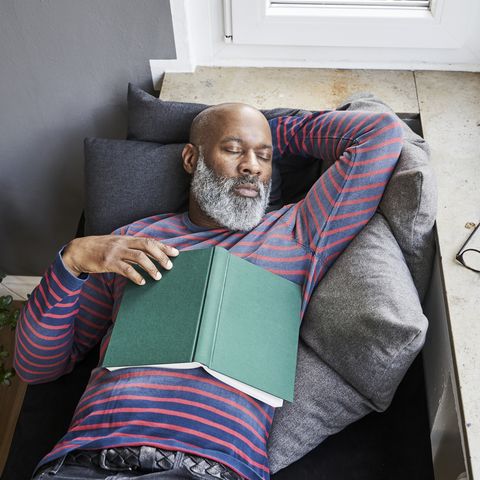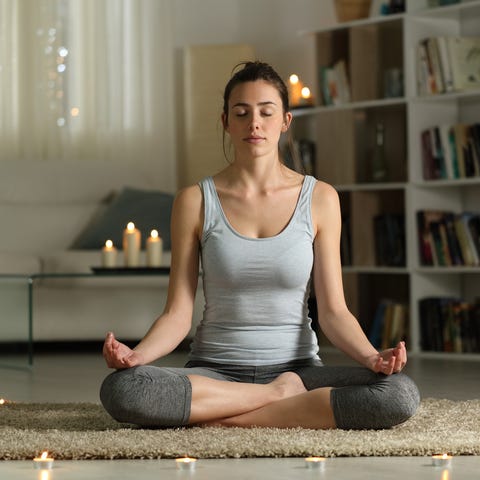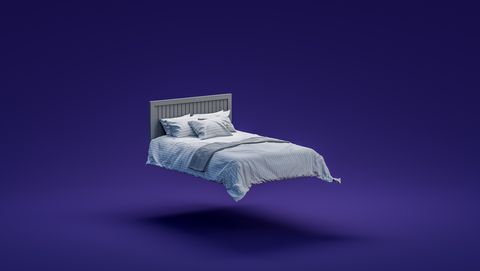Some people are just not meant to sleep 8 hours straight. If you’ve ever woken up at, say, 2 a.m. and decided to get out of bed, read a book or watch some Netflix, have a snack, then tuck yourself back in for another few hours, you’ve already experimented with biphasic sleep. And if you have the kind of work schedule where you can hit the couch for a refreshing midday snooze? You’re also a biphasic sleeper.
What is biphasic sleep?
Biphasic sleep simply means that instead of sleeping in one long stretch during the night (known as “monophasic sleep”), you break your snooze time into two distinct chunks. Also called “segmented sleep” or “bimodal” sleep, biphasic is the way most humans are believed to have slept before the Industrial Revolution and electric lights pushed us into a schedule of one long sleep.
“We have records that show that without electric light, individuals would fall asleep shortly after sunset, sleep for four to five hours, then wake up, do activities like talking to their loved ones and playing games, then return to sleep for another few hours before the sun rose,” says Rebecca Robbins, Ph.D., an instructor in medicine at Harvard Medical School and sleep expert for Oura.
In fact, humans are the only mammals who routinely sleep only at night, says Sarah Mednick, Ph.D., professor of cognitive science at the University of California, Irvine, and author of The Hidden Power of the Downstate: The New Science to Ignite Energy, Enhance Sharpness, and Reclaim Balance. “All other animals tend to nap during the day and then get up in the middle of the night,” she says. “The idea that we should be sleeping only during the night and not during the day is more modern, and maybe not as natural to our actual circadian rhythm,” she adds.
There are two basic types of biphasic sleep:
First sleep and second sleep:
With this schedule, you would go to bed early, sleep for a few hours, wake up for a break, then sleep for another few hours. The total should add up to the recommended 7-9 hours of sleep.
“In lab studies, looking at human’s sleep patterns in controlled photoperiods, it appears that we naturally fall into a rhythm of two phases of sleep with a one- to three-hour waking interval between them,” adds Bruce Bassi, M.D., a psychiatrist and founder of Telepsych Health. These two distinct blocks of sleep were called “first sleep” and “second sleep,” and the waking period in between was known as “the Watch” in English, and dorveille, meaning “wake-sleep,” in French. (Fun fact: In Colson Whitehead’s 2021 best-seller Harlem Shuffle, the main character wakes in the middle of the night to plan a revenge plot, and calls his wakeful time “dorvay,” from the vaguely remembered French term.)
Siesta/napping:
The two sleep phases in this schedule include a daytime snooze of an hour or more, then a nighttime sleep of at least 5 or 6 hours.
In many countries, including Spain and Italy, many people take a 60- to 90-minute nap in the afternoon and then sleep for fewer than 8 hours per night. It’s crucial not to confuse this schedule, which still adds up to at least 6 hours of sleep, to polyphasic sleeping (multiple short naps during the day), which often does not. “If one’s schedule allows it, an early afternoon nap would capitalize on the ‘circadian dip’ that naturally happens between 12 and 3 p.m.,” says Dr. Bassi. “One challenge with this strategy is that you can wake up groggy if you wake up in the middle of a deep sleep pattern,” he adds
What are the benefits of biphasic sleep?
- It can take the stress out of disrupted sleep: Much of the research on the benefits of two-stage sleeping is based on napping, not on first sleep/second sleep. However, Mednick points out that for some people, embracing a middle-of-the-night wakeful period can dial down stress. When many of us reach our 40s (especially women, who can experience sleep disturbances related to perimenopause), we may naturally fall into a biphasic pattern. “There’s a large population of people who start to wake up at night, and they start to freak out about it,” she says. “It can become a real psychological block.” However, for the people who decide to just roll with it and use that period to do something calming before going back to bed, it can ease the anxiety that comes from staring at the ceiling and counting down the hours until the alarm rings.
- It can improve cognition: Multiple studies have shown that taking a midday nap can help refresh your brain. “When you compare the type of cognitive benefits that you see with a full night of sleep, you see the same cognitive benefits with a nap,” says Mednick. “People show better verbal memory, better spatial memory, better creativity, better perception, better attentional processing, and better working memory.
- It can perk you up during the day: Studies have (not surprisingly) shown that taking a midday nap can alleviate daytime sleepiness, which is a big issue for people who do shift work, or who stay up late scrolling on their phones. As Dr. Bassi points out, we have a natural “circadian dip” between 12 and 3 p.m., making it the perfect time to take a refreshing siesta. Of course, this is only possible if you work from home, work at night or have an office with a door and a couch and a very understanding boss.
- It can kick up your athletic performance: One recent review of nap studies found that a midday nap was beneficial to athletes by improving short-term performance, endurance, and specific skills. The study concluded that a 90-minute nap was ideal.
What are the risks of biphasic sleep?
Robbins, who does not recommend biphasic sleeping, points out that this schedule was originally done out of necessity, not by choice. “We see that consolidated sleep offers the most benefits to our mental, emotional, and physical health,” she says.
Biphasic sleep could become risky if you are not able to get into a deep, restorative phase of sleep in either of your two segments. Robbins points out that this type of “fragmented sleep” can increase the risk for:
- Sleepiness
- Poor performance at work or school
- Fatigue
- Irritability
- Car accidents and illness
Tips for trying biphasic sleeping:
If you still want to give it a try …
- Make sure your two segments add up to a full night’s sleep: Whether you choose to nap in the middle of the day or do two phases of nighttime sleep, your total sleep time should add up to at least 7 hours, and any nap should ideally be at least 60 minutes. “You need to sleep at least an hour to get into slow-wave sleep, which is the most restorative stage of sleep,” says Mednick, who adds that it’s also important to sleep long enough to get into the REM stage, which is important for creativity and also easier to wake out of.
- Keep the lights low during your dorveille: When you get up between first and second sleep, don’t sit at your computer or scroll your phone — that will hit you with blue light, which tells your brain to get up for the day. Mednick recommends you keep a pair of blue-light glasses next to your bed. “These are very powerful for reducing any kind of blue wavelengths that are coming into your eyes that will tell you it’s morning.”
- Spend your midnight hours doing something calm: When you get out of bed between your two sleeps, you could take a tip from Ben Franklin and take “cold air baths,” (i.e., walk around the house naked), or you can do something that will keep you rested, like reading a book (on paper rather than on a screen), meditating or practicing yoga or having sex (as long as your partner is in on this plan as well). To avoid having this late-night window of waking turn into a time of worrying, Mednick advises you to write down anything you have on your mind. “For a lot of people, when they wake up, their mind starts racing,” she says. “When that happens, write your ideas down on paper, so you can close the loop, because sometimes that kind of repetitious thinking is just your brain saying, Don’t forget this!”
- Stay consistent: Whichever style of sleep you choose, it’s important to maintain a consistent schedule, going to bed and waking (whether that’s once or twice a night) at the same time each night, so your body knows it’s time to power down. Maintaining a regular bedtime routine (cup of decaf tea, 10 minutes of meditating, brush teeth, bed, etc.) can also help ease you to sleep
Bottom line:
Biphasic sleeping is not for everyone. “For many people, a biphasic sleep pattern at night is not feasible with their schedule,” says Dr. Bassi. “It would require going to bed earlier and waking up later.” Plus, he points out, being up for a couple of hours in the middle of the night leaves you with limited options: “Everyone else is sleeping, no stores are open, and engaging in any rigorous activity may disrupt the second phase of sleep,” he says.
But for others, it could be a way of embracing a pattern of sleeping that is more aligned with their personal rhythms. “With so many people working from home over the last few years, it has reopened the question about what is your own natural cycle,” says Mednick. “I think that’s pretty exciting for people to not necessarily be run by the clock outside them, but to be run by their internal clock.”
Marisa Cohen is a contributing editor in the Hearst Lifestyle Group’s Health Newsroom, who has covered health, nutrition, parenting, and culture for dozens of magazines and websites over the past two decades.
This content is imported from OpenWeb. You may be able to find the same content in another format, or you may be able to find more information, at their web site.



